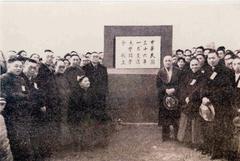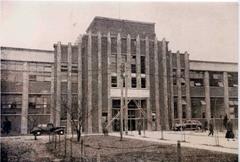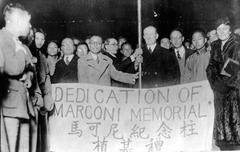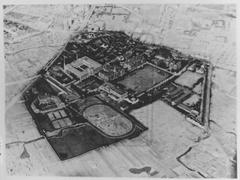
Shanghai Jiao Tong University Xuhui Campus
Shanghai Jiao Tong University Xuhui Campus Visiting Hours, Tickets, and Attractions Guide
Date: 14/06/2025
Introduction
Shanghai Jiao Tong University’s Xuhui Campus is a vibrant symbol of China’s educational evolution, architectural heritage, and cultural significance. Established in 1896 as Nanyang Public School during the late Qing Dynasty, the campus is located in the heart of Shanghai’s Xuhui District—a neighborhood renowned for its blend of Western and Chinese influences. Over its long history, the campus has become a living showcase of diverse architectural styles, from neoclassical masterpieces by architects like Laszlo Hudec, to traditional Chinese motifs and modern additions. Not only is the Xuhui Campus a center of academic excellence, but it also preserves key historical landmarks and offers lush green spaces, inviting libraries, and comprehensive visitor amenities (China Admissions, Antai College Story).
This guide delivers detailed information for visitors, including campus history, architectural highlights, practical visitor information, travel tips, nearby attractions such as Xujiahui Cathedral and the Xujiahui Shopping District, and frequently asked questions. Whether you are passionate about architectural heritage, maritime history, or seeking a genuine academic atmosphere, this article equips you with everything needed to make the most of your visit (SJTU Museums, cuecc.com).
Table of Contents
- Introduction
- History and Significance
- Architectural Heritage
- Campus Layout and Navigation
- Visiting Hours, Tickets, and Accessibility
- Guided Tours and Special Events
- Visitor Facilities and Amenities
- Transportation and Travel Tips
- Notable Alumni and Contributions
- Nearby Attractions
- Frequently Asked Questions (FAQ)
- Conclusion
- References
History and Significance
Founded as Nanyang Public School in 1896, Shanghai Jiao Tong University’s Xuhui Campus has played a pivotal role in the modernization of Chinese higher education. From its earliest days in a district influenced by French Catholic educational institutions, Xuhui Campus has evolved in tandem with China’s social and technological progress. The campus has survived periods of political upheaval, war, and institutional restructuring, including the formation of Xi’an Jiaotong University in the 1950s and the development of the main undergraduate Minhang Campus in 1987. Today, Xuhui remains a vibrant center for graduate studies, research, and cultural preservation (China Admissions).
Architectural Heritage
Engineering Building: Laszlo Hudec’s Masterpiece
The Engineering Building, designed by renowned architect Laszlo Hudec, is a standout feature of the campus. Constructed in 1934, it is celebrated for its neoclassical symmetry and modernist flair. Its historical and architectural value has led to its designation as a national key cultural relic (Antai College Story).
Library Complex
The campus library originated as a reading room in 1896 and expanded into a full-fledged library in 1919. Subsequent developments have added modern facilities, but the Xuhui Campus library remains a central academic and architectural landmark (China Admissions).
Heritage Preservation
Xuhui Campus is officially recognized as “Heritage Architecture” by the Shanghai Municipal People’s Government. Recent restoration projects, such as the renovation of the Engineering Building, are supported by alumni and philanthropic contributions (Antai College Story).
Campus Layout and Navigation
The 21-hectare campus, located at No. 1954 Huashan Road, is organized around quadrangles, tree-lined avenues, and open lawns, creating a tranquil park-like atmosphere (cuecc.com). Main campus zones include:
- Academic Area: Historic teaching buildings, libraries, and faculty offices.
- Administrative Area: Administration Building and university offices near the main gate.
- Student Life Area: Dormitories, cafeterias, recreational spaces.
- Green Spaces: Landscaped gardens and flowering trees throughout.
Bilingual signage, clear maps, and intuitive pathways make navigation easy for all visitors. Official campus map.
Visiting Hours, Tickets, and Accessibility
- Visiting Hours: Generally open to visitors from 8:00 AM to 6:00 PM daily. Museums and special exhibitions may have specific hours.
- Admission: Free access to campus grounds. Some museums (e.g., C. Y. Tung Maritime Museum) may require a reservation for guided tours.
- Registration: All visitors must register via QR code at campus entrances and provide valid ID (en.naoce.sjtu.edu.cn).
- Accessibility: Wheelchair ramps, elevators, and accessible restrooms are available in most buildings. For specific needs, contact the International Student Center.
- Guided Tours: Tours can be booked in advance, focusing on architectural and cultural highlights, available in English and Mandarin.
Visitor Facilities and Amenities
- Rest Areas and Dining: Shaded benches, gardens, cafeterias, and coffee shops with Chinese and Western options.
- Wi-Fi: Free access campus-wide; registration may be required at the info desk.
- Souvenirs: Bookstore near the main entrance offers SJTU merchandise and academic texts.
- Restrooms: Modern and accessible facilities throughout the campus.
- Security: On-site security and CCTV surveillance ensure visitor safety.
Transportation and Travel Tips
- Metro: Walking distance from Xujiahui Station (Lines 1, 9, 11) and Shanghai Library Station (Line 10).
- Bus: Multiple routes serve the campus area.
- Shuttle Bus: Connects Xuhui and Minhang campuses on a set schedule, with priority for faculty/staff (SJTU Shuttle Bus Info).
- On-Campus: Pedestrian-friendly and bike rentals available; motor vehicles are restricted.
Visitor Tips:
- Bring ID for campus entry.
- Use a translation app if needed.
- Avoid peak hours (weekday mornings); weekends are quieter.
- Photography is permitted outdoors and in museums, but check local signage for restrictions.
Notable Alumni and Contributions
Distinguished graduates include Jiang Zemin (former President of China) and Qian Xuesen, known as the “father of China’s rocket program.” The university’s alumni have played crucial roles in advancing China’s science, technology, and economy.
Nearby Attractions
- Xujiahui Cathedral (St. Ignatius Cathedral): A landmark of Gothic Revival architecture.
- Bibliotheca Zi-Ka-Wei (Xujiahui Library): Among Shanghai’s oldest libraries.
- Xujiahui Shopping District: Offers shopping, dining, and entertainment.
- French Concession: Historic streets and architectural landmarks.
- Shanghai Film Art Center: A cultural hotspot nearby.
Museum Highlight: C. Y. Tung Maritime Museum
- Location: New Zhong Yuan, Xuhui Campus.
- Hours: Tuesday to Sunday, 9:00 am to 5:00 pm; closed Mondays and public holidays (Maritime Museum).
- Admission: Free; group visits and guided tours require advance booking.
- Exhibits: Ancient Chinese shipping history (first floor) and the life of shipping magnate C. Y. Tung (second floor), with bilingual labels and full accessibility features.
Accommodation
- On-campus: Reserved for international degree students and scholars; limited options for short-term visitors (SJTU Accommodation).
- Off-campus: Numerous hotels in Xujiahui District, suitable for all budgets.
Safety and Cultural Etiquette
- Campus is smoke-free except in designated areas.
- Respect academic activities and local customs.
- Dress modestly and avoid entering classrooms without permission.
Frequently Asked Questions (FAQ)
Q: What are the visiting hours for Xuhui Campus?
A: 8:00 AM to 6:00 PM daily; some buildings may have different schedules.
Q: Is there an entry fee?
A: No. Campus entry is free; some museums or tours may require a reservation.
Q: Are guided tours available?
A: Yes; book in advance via the International Student Center.
Q: How do I get to the campus?
A: Metro Lines 1, 9, 10, and 11; several bus routes.
Q: Is the campus accessible to people with disabilities?
A: Yes; most buildings and museums are wheelchair accessible.
Q: Can I stay on campus as a visitor?
A: On-campus accommodation is mainly for international degree students; visitors should book nearby hotels.
Conclusion
Shanghai Jiao Tong University’s Xuhui Campus is much more than an academic institution—it is a living monument to China’s educational, architectural, and cultural transformation. Its blend of historic and modern architecture, accessible facilities, and proximity to some of Shanghai’s most famous attractions make it an essential stop for any visitor. Plan your visit by checking the latest hours and tour options, register upon arrival, and explore the campus’s rich history and vibrant present.
For interactive maps, audio guides, and campus news, download the Audiala app and follow SJTU and Audiala on social media.
Contact Information
- Address: No.1954 Huashan Road, Xuhui District, Shanghai, China
- C. Y. Tung Maritime Museum: Official Website
- General Inquiries: +86 21 54740000
- International Student Center: Contact Page
References
- China Admissions, 2025, Shanghai Jiao Tong University Overview
- Antai College Story, 2025, Engineering Building Preservation
- SJTU Museums, 2025, Campus Museums and Exhibitions
- cuecc.com, 2025, Living in China: SJTU Xuhui Campus
- SJTU International Student Center, 2025, Visitor Support Services
- Maritime Museum, 2025, C. Y. Tung Maritime Museum Official Site

























































































